Home » Research Advances
Ultra-antireflective synthetic brochosomes
Nature Communications (2017, 8,1285)
DOI: 10.1038/s41467-017-01404-8
The natural lives have been prompted to gain some unique functions by the natural laws of natural selection and the screening mechanism of the survival of the fittest in the evolution of millions of years. The implementation of such unique features often relies on well-designed micro-nanostructures. For example, the colorful colors of butterfly wings are derived from micro-nano grooves or pit arrays; the reason why can the lotus live in the silt but not imbrued is due to thousands of ordered micro-nano protrusions. Many devices with excellent performance have been designed by studying the relationship between structure and function in nature. However, there are many organisms in nature that have unique functions to be revealed, mitochondria secreted by aphids is one of these important examples.
The mitochondria are hollow micron-sized particles with a closely packed pit structure on the shell that makes it look like football or fullerenes. The mites continue to smear the secreted mitochondria to the body. Biologists have found that an important reason for this is that the mitochondrial coating forms a superhydrophobic surface, preventing the mites from being contaminated by sticky excrement secreted by other aphids. Biologists predict that mitochondria, one of the most complex structures in nature, must have many other unknown functions, including optics, thermals, courtship, and so on. However, limited to the difficulty in obtaining a large amount of mitochondria, the research on mitochondrial function has become extremely difficult.
In the November 3rd issue of Nature Communications (2017, 8,1285), Research Professor Shikuan Yang from Zhejiang University and Professor Tak-Sing Wong of Pennsylvania State University developed a template-assisted, seed layer-induced electrochemical deposition method to prepare a large-area artificial granule coating with a uniform structure. The structure of the mitochondria can be accurately controlled, which provides numerous samples for the systematic study of the association between mitochondria structure and its functions. Combined with a large number of experimental tests and numerical simulations, the intrinsic correlation between structural parameters of mitochondrial and the reflection of electromagnetic waves is established. It is found that the structure-optimized mitochondria have excellent anti-reflection properties in the visible to near-infrared region, and thus have important application prospects in the fields of energy, sensing and optoelectronic devices.
In addition, it is expected to obtain a mitochondrial coating with excellent anti-reflection properties in the middle and far infrared bands by designing the microstructure of the mitochondria, which provides a possibility for efficient use of solar energy. The mitochondria preparation method has strong universality and is suitable for preparing metals, metal oxides, conductive polymers, and even multi-component mitochondria, which lays a foundation for the development of mitochondria in other fields. Finally, studies have revealed that mitochondria are likely to be used as a camouflage coating to aid in the detection of mites to escape predators.
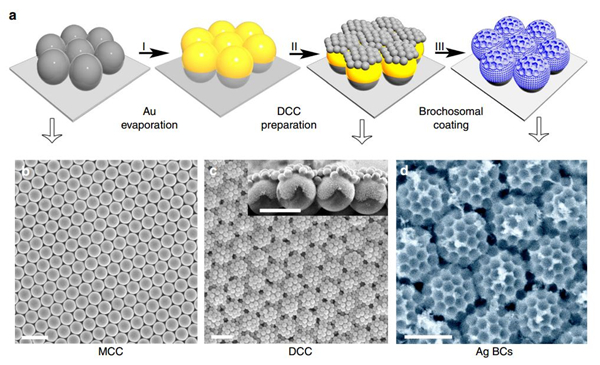
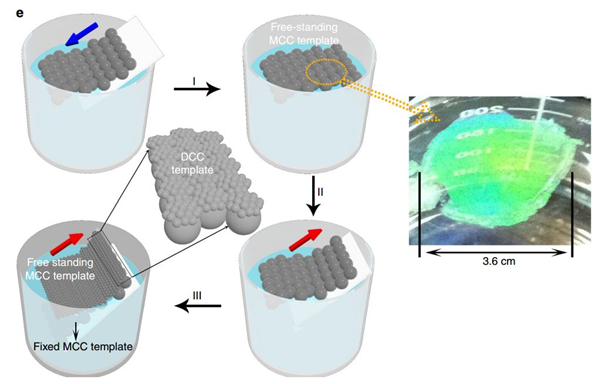
Fig. 2 Fabrication of synthetic brochosomal coating. a Fabrication process of the synthetic BCs. I. Gold evaporation. II. Preparation of DCC template. III. DCC template-based site-specific electrochemical deposition which creates BCs after PS spheres removal. b�Cd SEM images of MCC template (scale bar, 2 µm), DCC template (scale bar, 2 µm, and inset, 2 µm), and Ag BCs (scale bar, 2 µm), respectively. e Fabrication process of DCC template. I. MCC template transferred onto the air/water interface. II. MCC template transferred onto another arbitrary substrate. III. DCC template created by transferring another layer of MCC template onto a pre-fabricated MCC template that was thermally anchored on a substrate. Note that the thermal treatment of the MCC template around the glass transition temperature increases the interfacial area, thereby enhancing the binding between the PS spheres and the silicon substrate.
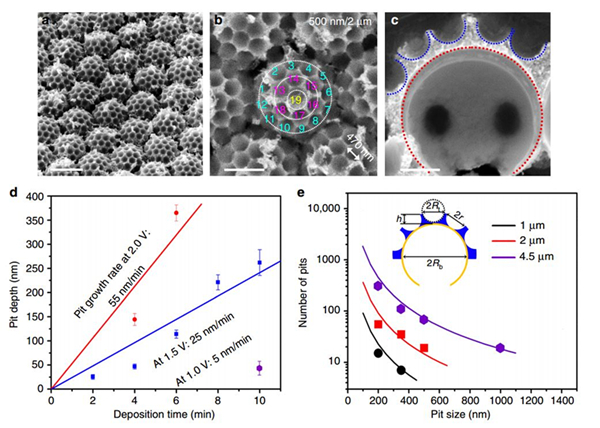
Fig. 3 Structural control of BCs. a, b SEM images of Ag BCs at different magnifications. Scale bars: (a) 2 µm, and (b) 1 µm. c Cross-sectional image of a silver brochosome particle. Scale bar: 500 nm. d A plot showing the growth rate of pit depth at different electrodeposition voltages. Error bars represent standard deviations from 100 independent measurements of the pits. e A plot showing the relationship between the number of pits and the pit size on the brochosome particles for a given size of bottom layer spheres (labeled in inset). Solid lines indicate theoretical predictions. Inset showing the schematic of the relevant geometrical parameters of a brochosome-like particle
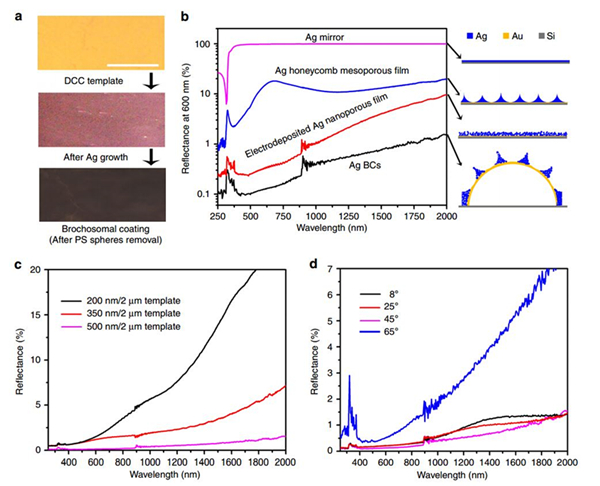
Fig. 4 Antireflection performance of the synthetic BCs. a Optical images of DCC template before and after Ag electrochemical growth, and after the removal of PS beads. Scale bar: 5 mm. b A plot showing the reflection spectra of Ag mirror (in magenta), Ag honeycomb mesoporous film (in blue), Ag nanoporous film (in red) and Ag BCs (in black). Schematic drawings of the corresponding structures are shown on the right. The Ag BCs were prepared by using the DCC template composed of 2 µm large PS spheres with the top surface covered by 500 nm PS spheres. After electrodeposition, the pits of these BCs were 470 nm in opening size and 260 nm in depth. The Ag honeycomb mesoporous film was prepared by electrodeposition using 500 nm PS spheres on an Au-covered silicon wafer. The depth of the pits was ~250 nm (Supplementary Fig. 14). c A plot showing the reflection spectra of BCs with different pit sizes. d A plot showing the angle dependence of the reflection spectra of the Ag BCs composed of 2 µm particles with pits 470 nm in opening size and 260 nm in depth
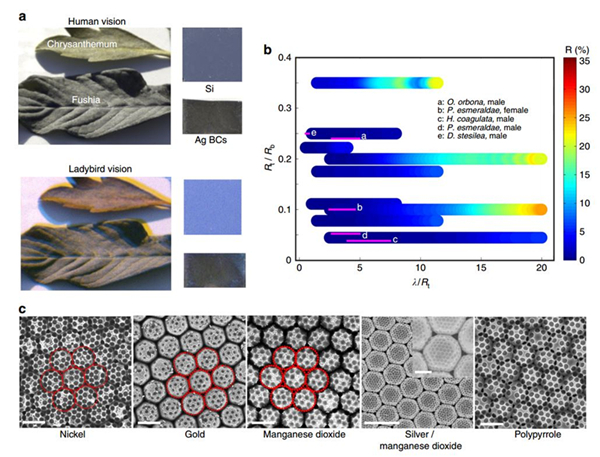
Fig. 5 Possible camouflage function of BCs and their fabrication in different materials compositions. a Simulated human and ladybird beetle visions of BCs and two different leaf species. b Comparison of the structural parameters of natural and synthetic brochosomes for their optical reflectance; here, the color bar represents the experimental reflectance measurements of various synthetic BC structures and the magenta lines represent the natural brochosomes (i.e., the visible spectrum of the ladybird over Rt determines the line length and position along the x-axis). These natural brochosomes include a Oncometopic orbona, male. b Proconia esmeraldae, female. c Homalodisca coagulata, male. d Proconia esmeraldae, male. e Diestostemma stesilea, male (Supplementary Fig. 24). The observing (incident) angle is 45��. Note that the geometrical parameters of the aforementioned natural brochosomes are located at the low reflection region in the optical reflectance map obtained from the reflectance measurements of the synthetic brochosomes. The normalized plot allows one to identify the corresponding antireflection design parameters of the synthetic brochosome given a specific wavelength of light. c Scanning electron micrographs showing various BCs fabricated from nickel (Ni), gold (Au), manganese oxide (MnO2), silver/manganese oxide (Ag/MnO2), and polypyrrole (PPy). Scale bars: 2 µm (Ni, Au, MnO2, PPy) and 5 µm (Ag/MnO2, inset, 2 µm)
In 2016, the same team members applied a lubricant-impregnated surface, inspired by the pitcher, as the ultra-efficient enrichment surface of the molecule to be detected, and developed the slippery liquid-infused porous surface-enhanced Raman scattering (SLIPSERS) platform. And it has shown that traces of pollutants, biomolecules, etc. present in any liquid can be subsequently detected through SLIPSERS (PNAS, 2016, 113, 268-273). At present, the research team of Shikuan Yang is further optimizing the SLIPSERS platform to obtain a practical and usable detection system. ��Website: http://person.zju.edu.cn/shkyang/698350.html��
Papers:
Shikuan Yang*, Nan Sun, Birgitt Boschitsch Stogin, Jing Wang, YuHuang & Tak-Sing Wong*, Ultra-antireflective synthetic brochosomes, NatureCommunications2017, 8, 1285. ��https://www.nature.com/articles/s41467-017-01404-8��
ShikuanYang*, Xianming Dai, Birgitt Boschitsch Stogin & Tak-Sing Wong*,Ultrasensitive surface-enhanced Raman scattering detection in common fluids. PNAS,2016, 113, 268-273. ��http://www.pnas.org/content/113/2/268.abstract��

